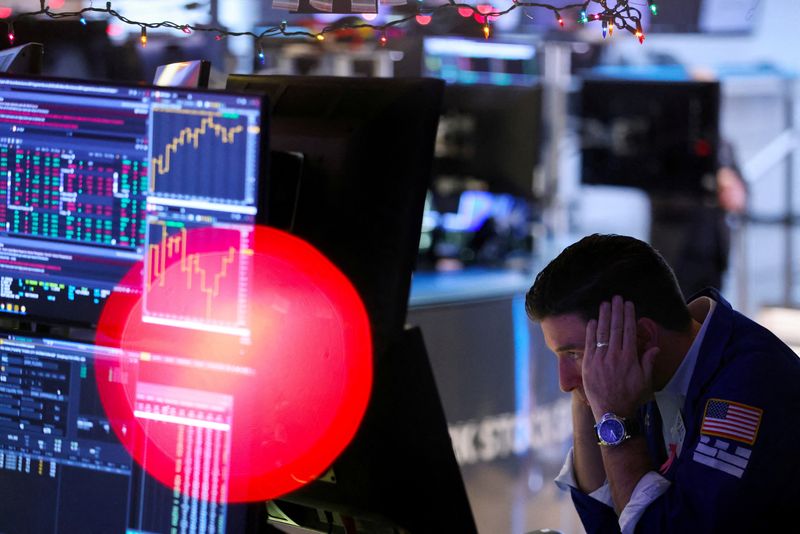By Stephen Culp
NEW YORK (Reuters) - U.S. stocks closed sharply lower to extend their three-day losing streak on Monday and Treasury yields advanced, with few catalysts to dissuade risk-off sentiment at the beginning of a likely low-volume, pre-holiday week.
All three major U.S. stock indexes ended near their session lows as investors resumed last week's flight to safety, which was driven by recession worries and the Federal Reserve's renewed vow to keep interest rates at restrictive levels until the inflation beast is tamed.
"Negative sentiment is reinforcing negative sentiment, feeding on itself," said Rob Haworth, senior investment strategist at U.S. Bank Wealth Management in Seattle. "(Investors are) worried about recession and higher rates and there’s not a lot of news to reverse the trend."
With just two weeks remaining in 2022, the S&P 500, the Dow and the Nasdaq are on track to notch their largest annual percentage losses since 2008, the nadir of the global financial crisis.
But Haworth said, "This just isn’t 2008, this is not an economy with a lot of bad debt that needs to be reconciled," adding, "There’s a risk of a mild recession, (but) consumer balance sheets, corporate balance sheets are strong."
Market participants had been hopeful that signs of economic softness could translate to a dovish pivot from the Federal Reserve, but those hopes were dashed when the central bank downgraded its economic outlook and warned that interest rates will climb higher and stay there longer than many might have hoped.
"The overwhelming theme of 2022 has been all about inflation and the Fed’s policy response," said Huw Roberts, head of analytics at Quant Insight in London. "Just as markets get excited by a dovish pivot, (they) are undone by policy tightening."
Data due this week, including housing starts, existing home sales, consumer spending and inflation, is likely to provide a sharper focus on the extent to which the central bank's efforts to toss cold water on the economy are having their intended effect.
The Dow Jones Industrial Average fell 162.92 points, or 0.49%, to 32,757.54, the S&P 500 lost 34.7 points, or 0.90%, to 3,817.66 and the Nasdaq Composite dropped 159.38 points, or 1.49%, to 10,546.03.
European shares regained some ground lost last week, with an assist from the energy sector as crude prices rose, reflecting hopes of demand recovery in China as Beijing relaxed COVID-19 restrictions.
The pan-European STOXX 600 index rose 0.27% and MSCI's gauge of stocks across the globe shed 0.64%.
Emerging market stocks rose 0.02%. MSCI's broadest index of Asia-Pacific shares outside Japan closed 0.23% lower, while Japan's Nikkei lost 1.05%.
U.S. Treasury yields rose as investors considered how high the Federal Reserve will hike interest rates in its protracted battle against inflation.
Benchmark 10-year notes last fell 31/32 in price to yield 3.5938%, from 3.482% late on Friday. Prices move inversely to yields.
The 30-year bond last fell 66/32 in price to yield 3.6405%, from 3.533% late on Friday.
The dollar edged lower against a basket of world currencies, which were boosted by a steadying risk appetite.
The dollar index rose 0.01%, with the euro up 0.2% at $1.0603.
The Japanese yen weakened 0.16% versus the greenback at 136.95 per dollar, while sterling was last trading at $1.2143, up 0.02% on the day.
Crude prices rebounded on hopes of strengthening demand in the wake of China's relaxation of its zero-COVID policy, but recession jitters held those gains in check.
U.S. crude rose 1.21% to settle at $75.19 per barrel, while Brent settled at $79.80, up 0.96% on the day.

Gold inched lower in thin trading, as rising yields on expected future interest rate hikes helped offset weakness in the greenback.
Spot gold dropped 0.3% to $1,786.69 an ounce.
